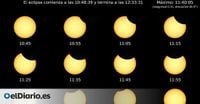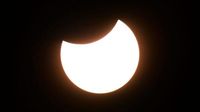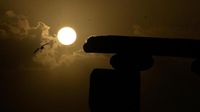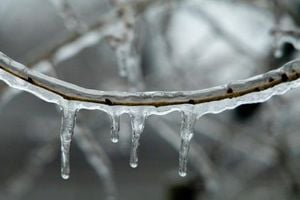On Saturday, March 29, 2025, millions of people across Spain witnessed a spectacular partial solar eclipse, marking the beginning of a unique astronomical era. This event was particularly significant as it is the first of a series of eclipses that will sweep across the Iberian Peninsula over the next few years, including two total eclipses in 2026 and 2027, and an annular eclipse in 2028.
As the eclipse commenced in the middle of the North Atlantic at 10:12 a.m. local time, it quickly became visible in the Canary Islands. By 10:39 a.m., the phenomenon reached the mainland, first appearing in Huelva and Cádiz, with its maximum coverage at approximately 11:40 a.m. when a third of the sun was obscured by the moon. The eclipse concluded in Gipuzkoa at 12:41 p.m., marking a memorable day for astronomy enthusiasts and casual observers alike.
Antonio del Solar, a nearly 80-year-old astronomer, observed the eclipse using a telescope gifted to Madrid by the German Democratic Republic in 1986. "It would take 170 years walking to reach the sun and 156 days in a spacecraft," he remarked, engaging nearly 1,000 visitors at the Planetarium of Madrid who had gathered to witness the event.
Among the attendees was Luisa Rojas, 61, who expressed her excitement about the eclipse, stating, "This is my first solar eclipse, and I loved it. Next year, I plan to go to Galicia to see it again." Her enthusiasm echoed the sentiments of many who had traveled to various observatories, parks, and public spaces to enjoy the celestial spectacle.
The maximum magnitude of the eclipse was recorded at 43% in A Coruña at 11:40 a.m., where clouds briefly obscured the view but ultimately aided photographers by softening the sun's glare. Lieutenant Víctor de Ory from the Spanish Navy's Astronomy Section explained to attendees that it had been 113 years since a similar eclipse graced the peninsula. He noted that the upcoming total eclipses in 2026 and 2027 would be extraordinary events, with the latter expected to plunge parts of San Fernando into near darkness.
As the eclipse unfolded, families and friends gathered in various locations, including the Planetarium of Madrid and the Observatorio de la Armada de San Fernando, where 200 people participated in educational activities about astronomy. The excitement was palpable as Felipe Paredes, an astrophysicist, addressed a crowd of 1,500, explaining the characteristics of the eclipse and its significance.
In Barcelona, the event was celebrated with similar enthusiasm. Josep Masalles, president of the Aster Astronomical Group, experienced his 43rd eclipse, reminiscing about his first one over half a century ago. He noted, "Today is a small appetizer compared to the total eclipses coming up, but it helps us prepare for what’s next."
In the midst of the celebrations, safety precautions were emphasized. Astronomers warned against looking directly at the sun without proper protection, as conventional sunglasses do not suffice. Instead, they advised using eclipse glasses or indirect viewing methods, such as projecting the sun’s image onto a surface using simple household items.
As the eclipse progressed, people in cities like Madrid and Valencia prepared for their moments of maximum visibility. In Madrid, the peak was set for 11:40 a.m. with a 0.32 magnitude, while in other locations such as Seville and Pontevedra, the timings varied, showcasing the diverse experiences across the country.
In the Canary Islands, the eclipse peaked at 10:04 a.m. local time, with Gabriel and Ivan, a father-son duo, expressing their joy, stating, "This is the first eclipse we’ve really seen, and we’re already planning trips to the peninsula for the next ones." Their excitement mirrored the sentiments of many who were captivated by the celestial event.
With the eclipse now concluded, attention turns to the future. Astronomers have highlighted that two total solar eclipses will occur in Spain on August 12, 2026, and August 2, 2027. These events are expected to draw even larger crowds, as they promise to be visible in their totality across various regions, unlike the partial eclipse experienced today.
As the sun returned to its usual brightness, the day left many with a sense of wonder and anticipation for the next celestial events. The excitement surrounding this partial solar eclipse not only celebrated a moment of astronomical beauty but also marked the beginning of a new chapter in Spain’s astronomical history, one that promises to bring families and friends together under the marvels of the universe.









